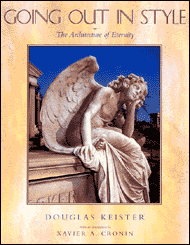
|
|
|
|
|
Submit email feedback on this item:
|

|
|
Filename :
|
GC093.JPG |
|
Description :
|
The Bache mausoleum in Woodlawn Cemetery in the Bronx is a replica of the Kiosk of Trajan at the Temple of Isis on the Nile River in Egypt. The mausoleum is bursting with symbolism. The lily topped columns signify the unfolding of life; vulture wings symbolize maternal care; twin cobras signify death and papyrus leaves symbolize knowledge and rebirth.
Bache Mausoleum
Woodlawn Cemetery
Bronx, New York
Woodlawn Cemetery in the Bronx is the final address of some of America’s wealthiest citizens. Jules Bache (1861-1944), rests among the many “robber barons” and millionaires he lived with. Bache made his living as a stockbroker and was a long time collector and patron of the arts, donating a number of Goyas and Rembrandts to the Metropolitan Museum of Art.
His tomb reflects his interest in the arts. He chose as his mausoleum, a replica of the elegant Kiosk of Trajan or “pharaoh’s bed” at the temple of Isis on the island of Philae on the Nile River. Bache’s Kiosk of Trajan was designed by architect John Russell Pope, who later designed the Jefferson Memorial in Washington D.C.
The sheer size of the Bache mausoleum makes it one of a kind. The hallmarks of the Bache mausoleum are the massive columns which are capped with abstractions of lotus blossoms (signifying the unfolding creative universe) and the open roof design. Other replica mausoleums are common in cemeteries; interpretations of the Parthenon, Pantheon, Gothic chapels and cathedral replicas may be seen in most large metropolitan cemeteries.
Isis was one of humankind’s most worshipped Goddesses. The ancient scholar Apuleius gave her a voice in The Golden Ass: “At my will the planets of the sky, the wholesome winds of the sea, and the lamentable silences of Hell are disposed; my name, my divinity is adored throughout the world.” Perhaps Bache felt inspired by Isis’ teachings. |
|

